Ad
Structure of c_program_to_input_output
- 1. Topics To Be Covered Structure Of C Program Identifiers Basic Data Types And Sizes Constants Variables Expressions Operators Input/output Statements
- 2. Structure of a C Program Every C program consists of one or more modules called functions. One of the functions must be called main. The program will always begin by executing the main function Each function must contain: 1. A function heading, which consists of the function name, followed by an optional list of arguments, 1. A list of argument declarations, if arguments are included 3. A compound statement, which comprises the remainder of the function. • Each compound statement is enclosed within a pair of braces, { }. • Compound statements may be nested, one within another • Each expression statement must end with a semicolon (; )
- 3. Example Use Of Comments
- 4. The comments at the end of each line have been added in order to emphasize the overall program organization Normally a C program will not look like this. Rather, it might appear as shown below. Execution of the program results in an interactive dialog such as that shown below. The user's response is underlined, for clarity. Radius = 7 3 Area = 28.274309
- 5. IDENTIFIERS AND KEYWORDS identifiers are names that are given to various program elements, such as variables, functions and arrays. Identifiers consist of letters and digits, in any order, except that the first character must be a letter. Both upper- and lowercase letters are permitted, though common usage favors the use of lowercase letters for most Types of identifiers. Upper- and lowercase letters are not interchangeable The underscore character ( - ) can also be included, and is considered to be a letter. An underscore is often used in the middle of an identifier. An identifier may also begin with an underscore, though this is rarely done in practice.
- 6. The following names are not valid identifiers ,For the reasons stated. The following names are not valid identifiers For the reasons stated.
- 7. Some Other Points About Identifiers The identifiers file-manager and file-management are both grammatically valid. Some compilers may be unable to distinguish between them, however, because the first eight letters are the same for each identifier. Therefore, only one of these identifiers should be used in a single C program. As a rule, an identifier should contain enough characters so that its meaning is readily apparent. On the other hand, an excessive number of characters should be avoided. A C program is being written to calculate the future value of an investment. The identifiers value or future-value are appropriate symbolic names. However, v or fv would probably be too brief, since the intended representation of these identifiers is not clear. On the other hand, the identifier future-value-of-an-investment would be unsatisfactory because it is too long
- 8. Keywords • There are certain reserved words, called keywords, that have standard, predefined meanings in C. • These keywords can be used only for their intended purpose; • They cannot be used as programmer-defined identifiers.
- 9. • The standard keywords are Some compilers also include some or all of the following keywords.
- 10. DATA TYPES • C supports several different types of data • Each may be represented differently within the computer’s memory • The basic data types are listed below (Next Slide). • Typical memory requirements are also given • The memory requirements determine the permissible range of values • • Note that the memory requirements for each data type may vary from one C compiler to another
- 11. C compilers written for personal computers or small minicomputers (i.e., computers whose natural word size is less than 32 bits) generally represent a word as 4 bytes (32 bits)
- 12. Points to Remember • The basic data types can be augmented by the use of the data type qualijiers short , long, signed and unsigned. • Integer can be defined as short int , long int or unsigned int • Usually written simply as short , long or unsigned • The interpretation of integer data type will vary from one C compiler to another • A short int may require less or same memory than an ordinary int but it will never exceed an ordinary int in word length. • A long int may require the same amount of memory as an ordinary in t or it may require more memory, but it will never be less than an ordinary int . • If short int and int both have the same memory requirements (e.g., 2 bytes), then long int will generally have double the requirements (e.g., 4 bytes)
- 13. Points to Remember • If int and long int both have the same memory requirements (e.g., 4 bytes) then short int will generally have half the memory requirements (e.g., 2 bytes) • An unsigned int has the same memory requirements as an ordinary i n t . However, in the case of an ordinary int , the leftmost bit is reserved for the sign. • With an unsigned int , all of the bits are used to represent the numerical value. Thus, an unsigned int can be approximately twice as large as an ordinary int (though, of course, negative values are not permitted). • For example, if an ordinary int can vary from -32,768 to +32,767 (which is typical for a 2-byte int ) , then an unsigned int will be allowed to vary from 0 to 65,535. The unsigned qualifier can also be applied to other qualified int
- 14. CONSTANTS There are four basic types of constants in C. 1. Integer constants, 2. Floating-point constants 3. Character constants 4. String constants Integer and floating-point constants represent numbers. They are often referred to collectively as numeric-type constants. The following rules apply to all numeric-type constants. Commas and blank spaces cannot be included within The constant can be preceded by a minus (-) sign if desired The value of a constant cannot exceed specified minimum and maximum bounds.
- 15. Integer Constants • An integer constant is an integer-valued number. • It consists of a sequence of digits. • Integer constants can be written in three different number systems: decimal (base lO), octal (base 8) and hexadecimal (base 16). • A decimal integer constant can consist of any combination of digits taken from the set 0 through 9. • If the constant contains two or more digits, the first digit must be something other than 0.
- 17. Octal Integer Constant An octal integer constant can consist of any combination of digits taken from the set 0 through 7. However the first digit must be 0,in order to identify the constant as an octal number.
- 18. Hexadecimal Integer Constant A hexadecimal integer constant must begin with either Ox or OX. It can then be followed by any combination of digits taken from the sets 0 through 9 and a through f (either upper- or lowercase). Note that the letters a through f (or A through F) represent the (decimal) quantities 10 through 15, respectively.
- 19. Unsigned and Long Integer Constants Unsigned integer constants may exceed the magnitude of ordinary integer constants by approximately a factor of 2, though they may not be negative.* An unsigned integer constant can be identified by appending the letter U (either upper- or lowercase) to the end of the constant. Long integer constants may exceed the magnitude of ordinary integer constants, to create a long integer constant by appending the letter L (either upper- or lowercase) to the end of the constant. An unsigned long integer may be specified by appending the letters UL to the end of the constant. The letters may be written in either upper- or lowercase. However, the U must precede the L.
- 21. Floating-Point Constants A floating-point constant is a base- 10 number that contains either a decimal point or an exponent (or both).
- 22. Character Constants A character constant is a single character, enclosed in apostrophes (i.e., single quotation marks). Several character constants are shown below. Escape Sequences Certain nonprinting characters, as well as the backslash () and the apostrophe (‘’ ), can be expressed in terms of escape sequences. An escape sequence always begins with a backward slash and is followed by one or more special characters.
- 23. The commonly used escape sequences are listed below.
- 24. String Constants A string constant consists of any number of consecutive characters (including none), enclosed in double quotation marks. Several string constants are shown below. Note that the string constant "Line 1n Line 2n Line 3" extends over three lines, because of the newline characters that are embedded within the string. Thus, this string would be displayed as Line 1 Line 2 Line 3 Also, notice that the string “ ” is a null (empty) string
- 25. EXPRESSIONS • An expression represents a single data item, such as a number or a character. • The expression may consist of a single entity, such as a constant, a variable, an array element or a reference to a function. • It may also consist of some combination of such entities, interconnected by one or more operators. • Expressions can also represent logical conditions that are either true or false. • In C the conditions true and false are represented by the integer values 1 and 0,respectively
- 26. Several simple expressions are shown below.
- 29. OPERATORS Arithmetic Operators There are five arithmetic operators in C. They are The % operator is sometimes referred to as the modulus operator. There is no exponentiation operator in C. There is a library finction (POW) to carry out Exponentiation.
- 30. Points to Remember • The operands acted upon by arithmetic operators must represent numeric values • Operands can be integer quantities, floating-point quantities • The remainder operator (%) requires that both operands be integers and the second operand be nonzero. • Division operator (/) requires that the second operand be nonzero. • Division of one integer quantity by another is referred to as integer division. • This operation always results in a truncated quotient (i.e., the decimal portion of the quotient will be dropped). • If a division operation is carried out with two floating-point numbers, or with one floating-point number and one integer, the result will be a floating-point quotient.
- 31. Suppose that a and b are integer variables whose values are 10 and 3, respectively. Several arithmetic expressions involving these variables are shown below, together with their resulting values.
- 32. Now suppose that vl and v2 are floating-point variables whose values are 12.5 and 2.0, respectively. Several arithmetic expressions involving these variables are shown below, together with their resulting values.
- 33. Suppose that a and b are integer variables whose values are 11 and -3, respectively. Several arithmetic expressions involving these variables are shown below, together with their resulting values.
- 34. Let rl and r2 be floating-point variables whose assigned values are -0.66 and 4.50. Several arithmetic expressions involving these variables are shown below, together with their resulting values.
- 35. Unary Operators C includes a class of operators that act upon a single operand to produce a new value. Such operators are known as unary operators. Unary operators usually precede their single operands, though some unary operators are written after their operands. Perhaps the most common unary operation is unary minus, where a numerical constant, variable or expression is preceded by a minus sign.
- 36. Relational And Logical Operators Equality Operators,
- 37. Suppose that i, j and k are integer variables whose values are 1, 2 and 3, respectively. Several logical expressions involving these variables are shown below logical operators / logical connectives
- 38. Assignment Operators There are several different assignment operators in C. Used to form assignment expressions Assign the value of an expression to an identifier The most commonly used assignment operator is = identifier = expression where identifier generally represents a variable expression represents a constant
- 39. Some typical assignment expressions that make use of the = operator In the following assignment expressions, suppose that i is an integer-type variable.
- 40. Now suppose that i and j are both integer-type variables, and that j has been assigned a value of 5. Several assignment expressions that make use of these two variables are shown below.
- 41. Multiple assignments Assignments Are Carried Out From Right To Left Above assignment equivalent to Suppose that i and j are integer variables. The multiple assignment expression will cause the integer value 5 to be assigned to both i and j . (To be more precise, 5 is first assigned to j , and the value of j is then assigned to i.) Similarly, the multiple assignment expression i = j = 5.9 ,will cause the integer value 5 to be assigned to both i and j .
- 42. Additional Assignment Operators The assignment expression is equivalent to The assignment expression is equivalent to expression 1 is an identifier, such as a variable or an array element
- 43. Suppose that i and j are integer variables whose values are 5 and 7, and f and g are floating-point variables whose values are 5.5 and - 3.25. Several assignment expressions that make use of these variables are shown below. Each expression utilizes the original values of i, j , f and g
- 44. The Conditional operator Simple conditional operations can be carried out with the conditional operator (? :). An expression that makes use of the conditional operator is called a conditional expression. A conditional expression is written in the form When evaluating a conditional expression, expression 1 is evaluated first. If expression 1 is true (i.e., if its value is nonzero), then expression 2 is evaluated and this becomes the value of the conditional expression. However, if expression 1 is false (i.e., if its value is zero), then expression 3 is evaluated and this becomes the value of the conditional expression.
- 45. In the conditional expression shown below, assume that i is an integer variable. The expression (i < 0) is evaluated first. If it is true, the entire conditional expression takes on the value 0. Otherwise ,the entire conditional expression takes on the value 100. In the following conditional expression, assume that f and g are floating-point variables. This conditional expression takes on the value off f if it is less than g; otherwise, the conditional expression takes on the value of g. In other words, the conditional expression returns the value of the smaller of the two variables.
- 55. Input/output Statements The Functions permits the transfer of information between the computer and the standard input/output devices e.g., a keyboard and a TV monitor These six are as follows: 1. getchar 2. putchar 3. scanf 4. printf 5. gets 6. Puts The header file required by the standard input/output library functions is called stdio .h
- 56. 1. SINGLE CHARACTER INPUT -THE getchar FUNCTION getchar function is a part of the standard C I/O library It returns a single character from a standard input device (typically a keyboard) The function does not require any arguments, though a pair of empty parentheses must follow the word getchar In general terms, a function reference would be written as character variable = getchar ( ) ; where character variable refers to some previously declared character variable.
- 57. A C program contains the following statements char c; . . . . . c = getchar(); The first statement declares that c is a character-type variable The second statement causes a single character to be entered from the standard input device (usually a keyboard) Then assigned to c
- 58. SINGLE CHARACTER OUTPUT -THE putchar FUNCTION Single characters can be displayed i.e., written out of the computer using the C library function putchar It is complementary to the character input function getchar It is a part of the standard C I/O library It transmits a single character to a standard output device (typically a TV monitor) It must be expressed as an argument to the function, enclosed in parentheses, following the word putchar In general, a function reference would be written as putchar ( character variable) where character variable refers to some previously declared character variable
- 59. A C program contains the following statements char c; . . . . . putchar(c); The first statement declares that c is a character-type variable The second statement causes the current value of c to be transmitted to the standard output device (e.g., a TV monitor) where it will be displayed.
- 60. EXAMPLE Lowercase to Uppercase Text Conversion
- 61. ENTERING INPUT DATA -THE scanf FUNCTION This function can be used to enter any combination of numerical values ,single characters and strings. The function returns the number of data items that have been entered successfully where control string refers to a string containing certain required formatting information arg1, arg2, . . . argn are arguments that represent the individual input data items The control string consists of individual groups of characters, with one character group for each input data item a single character group will consist of the percent sign, followed by a conversion character which indicates the type of the corresponding data item
- 62. Commonly Used Conversion Characters for Data Input
- 63. The arguments are written as variables or arrays, whose types match the corresponding character groups in the control string Each variable name must be preceded by an ampersand (a). (The arguments are actually pointers that indicate where the data items are stored in the computer's memory Here is a typical application of a scanf function.
- 64. WRITING OUTPUT DATA -THE printf FUNCTION Output data can be written from the computer onto a standard output device using the library function printf This function can be used to output any combination of numerical values, single characters and strings In general terms, the printf function is written as
- 65. where control string refers to a string that contains formatting information, and arg7, arg2, . . . , argn are arguments that represent the individual output data items. The arguments can be written as constants, single variable or array names, or more complex expressions. Function references may also be included. In a printf function do not represent memory addresses and therefore are not preceded by ampersands. The control string consists of individual groups of characters, with one character group for each output data item. Each character group must begin with a percent sign (%). In its simplest form, An individual character group will consist of the percent sign, followed by a conversion character indicating the type of the corresponding data item.
- 66. Commonly Used Conversion Characters for Data Output
- 67. Here is a simple program that makes use of the printf function. Notice that the first two arguments within the printf function are single variables, the third argument is an arithmetic expression, and the last argument is a function reference that has a numeric expression as an argument. Executing the program produces the following output: 2.000000 3.000000 5.000000 2.236068
- 68. The following skeletal outline indicates how several different types of data can be displayed using the printf function Within the printf function, the control string is "%s %d %f It contains three character groups. The first character group, %s, indicates that the first argument (item) represents a string. The second character group, %indicates that the second argument (part no) represents a decimal integer value, and the third character group, %indicates that the third argument (cost) represents a floating-point value.




















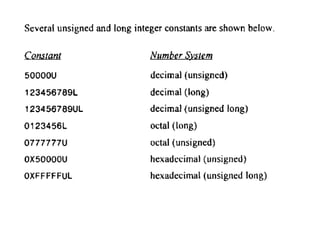














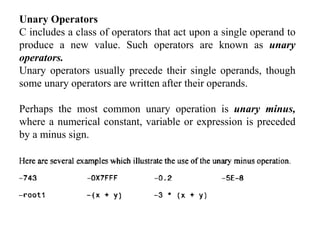

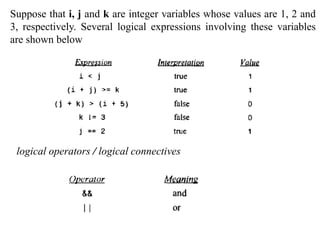


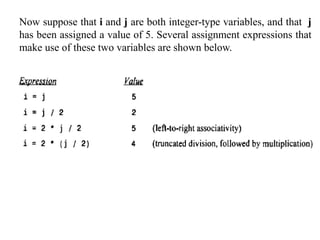



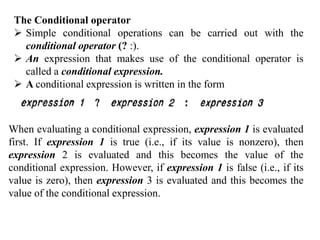





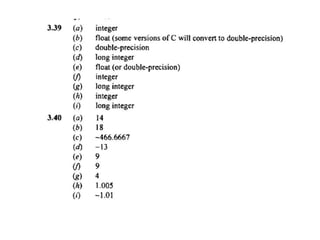







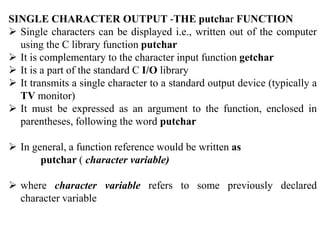

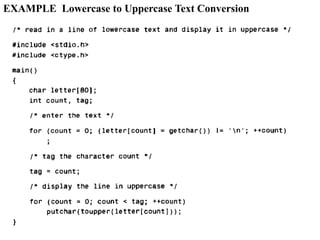



























































![[UX Project] C-Saw](https://cdn.slidesharecdn.com/ss_thumbnails/ux-c-saw-141226201838-conversion-gate01-thumbnail.jpg?width=560&fit=bounds)









































